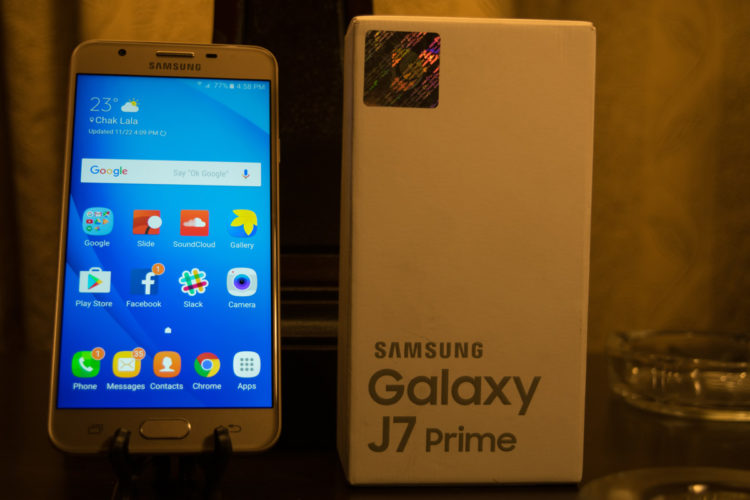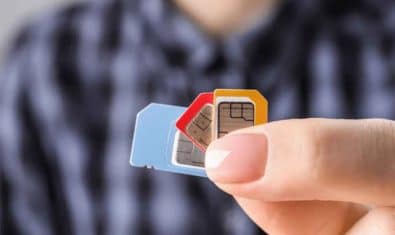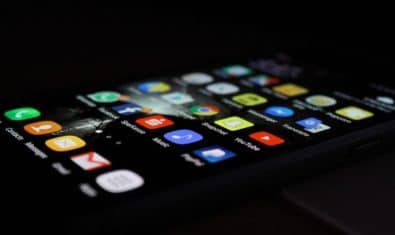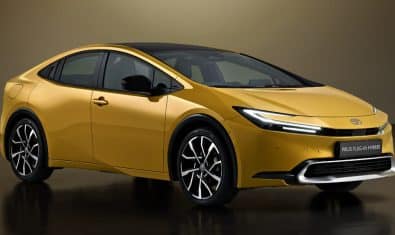Some recent high-end phones from Samsung, like the Note 7 (notwithstanding Battery-gate) and the S7 Edge, have impressed a lot of people with their superior build quality, performance and the great user experience that they offer. However, Samsung’s mid-range offering does not meet a lot of people’s expectations.
Samsung is now hoping to change that with the newly announced Galaxy J7 Prime. It comes with fairly good specifications that deliver a good user experience. So, without further ado, let’s get on with the full review and see what the J7 Prime offers.
Check Product: J7 2016
Design & Build Quality
About 2 years ago, even the top end Samsung phones didn’t use metal builds, let alone mid-range phones. Fortunately, that has now changed. The J7 Prime carries on the tradition of the recent A-series phones by using a metal body.
Without doubt, the metal body of the J7 Prime gives it a very premium feel. It looks solidly built and feels as if it could take a drop or two.
There’s also no flex of any kind. The front of the phone is protected by Gorilla Glass and the glass blends smoothly onto the metal on the side. In other words, it uses a 2.5D glass which results in no obtrusion between the glass and the metal.
Upfront, you have the 5.5-inch 1080p display along with your earpiece, sensors and the front camera on top of it, whereas on the bottom you have the standard Samsung button placement – home button in the middle accompanied by the multitasking key on the left side and the back key on the right. The keys aren’t backlit unfortunately.
On the back you have the flat metal surface with the primary camera and a single-LED flash. The camera lens also doesn’t protrude so the back is totally flat and you don’t have to worry about scratching the lens.
Finally you have the volume rocker, dual-SIM slot and a dedicated memory card slot on the left hand side. And on the right you have the power button and the loud speaker.
Now, the placement of the loudspeaker is very odd and a first for Samsung phones. Most of the times you get the loudspeaker either on the back or the bottom of the phone, but that’s not the case here. The speaker itself however is tiny and isn’t too loud.
Due to being placed on the upper right hand side, you often find yourself blocking the speaker when watching videos in landscape mode so you end up having to readjust your grip.
The buttons meanwhile are all very clicky and do not feel mushy.
Concluding this section, I would say that it is nice to see Samsung moving towards good and superior builds even in their mid-range budget offerings.
Display
Producing good displays is kind of Samsung’s forte and what they are known for in the tech industry. With each passing year, they make and market the best AMOLED display with their flagships. AMOLED panels are even found in some other mid-range offerings like the Galaxy A7 (2016).
However, instead of carrying on the tradition, Samsung chose to go with a 1920×1080 PLS-LCD screen. PLS is basically Samsung’s own version of IPS displays.
Apart from that, the PLS LCD display on the J7 Prime is not bad by any means. It is plenty sharp and when the brightness is turned all the way up – very easy to see even in direct sunlight. If that isn’t enough, Samsung includes an outdoor mode that boosts the brightness for 15 minutes for better visibility.
Contrast wise, I compared it to another FHD phone sporting a IPS LCD and there was noticeable difference. The IPS display produced much better viewing angles and more punchier, saturated colors. The PLS display on the J7 Prime wasn’t much behind and in real world usage you would be hard pressed to notice any difference.
Compared to the competition in this price range, no doubt, the J7 Prime offers a very good display that rivals most other smartphones but the inclusion of an AMOLED display would have been preferred here. Other than that, you have got yourselves a very nice display.
Performance
The Samsung Galaxy J7 Prime comes with the Exynos 7870, Samsung’s own processor. It’s an octa-core processor running at 1.6GHz. Backing it all up is 3GB of RAM.
I always stress that real world usage is more important than benchmarks since the benchmarks only tell one side of the story. My usage of the phone consisted of mostly using Facebook, WhatsApp, Chrome and playing a few games like Missiles, Asphalt 8, Dead Trigger 2 etc. It ran all that stuff with ease and didn’t slow down. You will be able to get consistent performance out of it in your daily tasks, which is more than enough. It performed decently during the time I used it.
The 3GB of RAM was very much welcome since you could see that it wasn’t closing applications in the background very aggressively and was able to retain most apps. Apart from that, I checked the usage of RAM and was surprised to see that it constantly had 1GB free RAM, which is quite a feat considering that it is using the infamous TouchWiz skin which is known to be very resource hungry.
I also ran a benchmark to see how it fared with some other devices and you can see the result for yourself:

Concluding this section up, I would say that the J7 Prime has more than enough horsepower to manage all of the tasks you throw at it. The improvement of the software certainly helped the J7 Prime with its ability to hold more applications in background while simultaneously giving around 1GB of free RAM.
Fingerprint Scanner
Fingerprint scanners are now becoming the norm and more and more phones are now seem using it. The J7 Prime is no exception.
Samsung doesn’t boast any special numbers with the fingerprint scanner but in my testing I found it to be very decent with it taking around less than half a second to unlock the phone. Now, you can use your fingerprint to unlock the phone in two ways. One is that you basically press the power button or home button and let it read your fingerprint. And secondly, you can now just rest your finger on the scanner even if the screen is off and it will read it and unlock the phone.
However, I have found that when using the former method, the response time was actually faster. You basically placed your finger on the scanner and it instantly unlocks your phone. Whereas in the latter method, I noticed that it mostly took a couple of tries before it actually gets around to unlocking the phone.
You also don’t get any special features with it such as assigning an app to each of your finger, which it launches when you unlock the phone. Not to mention that the maximum number of fingers you can enroll is only 3.
It does require you to sometimes place your finger on the sensor more than once. This isn’t a problem exclusive to the J7 Prime, in fact even the flagship devices suffer from this issue. I have used the Galaxy Note 7, Note 5 and also the S7 Edge and all of them had very inconsistent fingerprint scanners.
Despite these shortcomings, it is very, very convenient to have a fingerprint scanner on a phone and to use it, especially when you have a fast one. You don’t have to fiddle around with your patterns or PINs and waste time there.
Camera
Coming to a major part of the phone, let me give you some numbers beforehand. The primary camera on the J7 Prime is a 13MP SONY IMX258 sensor. It’s the same sensor that you would find on the Xiaomi Mi4, OnePlus X, Sony Xperia XA and a couple of other mid-range devices.
The J7 Prime is able to capture images in a 4:3 ratio coming at a resolution of 4128 x 3096. Let’s get to the actual images themselves.
Pictures taken during daytime are great. The camera produced high resolution images which also had good contrast. Exposure of the these shots wasn’t always on point though. It sometimes brightened the images too much that I had to lower it in post-processing or when taking the shot.
Close ups were also great, showing incredible amount of detail in the pictures. However, move into less bright conditions, and that’s where things start to fall apart. To start off, it takes a couple of seconds for the camera to actually focus. And when it does focus and you press shutter button, you are left feeling confused whether you’ll even share that photo with someone else or not. The images turn up very soft and due to the lower shutter speed required to compensate for the low light, expect some blur too if you are using it hand held. There is a flash included but obviously it can’t be used for landscapes.
The front camera sports a resolution of 8MP. It’s a fixed focus lens and you get to take photos at 4:3 coming at a resolution of 3264 x 2448. While the front camera takes some good quality and detailed selfies, it suffers a lot from trying to adjust the exposure.
The exposure compensation is by far the worst part about it. With your face in the center, it increases the exposure so much that it blows all the highlights in the background and almost everything is white. It takes a little while for you to precisely adjust the exposure by moving the camera in different directions. But when you get the exposure just right, the resulting selfie is a good enough to be used on social media and has enough detail in it.
You also get to double tap the home button to access the camera from anywhere. I loved using this feature and has helped me get some quick shots.
All in all, the J7 Prime sports a pretty decent camera for it’s price and it gets the job done. It’s not going to give the photo quality of something like the S7 Edge or the iPhone 7 Plus, but at this price point, is it actually a deal breaker? I don’t think so.
Following are some sample photos:





Connectivity and Storage
The J7 Prime includes a dual-SIM card slot and a dedicated microSD card slot. Both of the SIM slots are 4G ready and you can switch the connectivity between the two SIMs.
In terms of storage, the J7 Prime disappoints. You only get 16GB out of the box, out of which 5GB is already used by the system. After installing basic applications you are left with just 3GB of storage. This does create problems relating to performance of the phone. Luckily, there is a microSD card slot available from where you can add upto 256GB of external storage.
Battery Life
The Samsung Galaxy J7 Prime comes with a 3,300mAh battery which is non-removable.
The battery life on the J7 Prime is great. My day starts at 6am and I usually end up putting it on charging at the end of the day around 12am. This is with moderate usage which includes calling, messaging, leisure web browsing, taking a few photos and WhatsApp etc.
With a heavy day of gaming and lots of screen usage with high brightness, you will usually find yourself reaching for a charger around 7-8pm.
Stand by times are great with this phone. In fact, during my first few days with the phone when I didn’t have everything moved over to the J7 Prime, it gave me a battery timing of 2.5 days which included 7 hours of screen-on-time.
Software
Just like with the improvements in hardware, the software side of Samsung, namely TouchWiz, is also now improving. TouchWiz has now matured and is better than what it was back in the days.
You still get a very similar homescreen and the settings panel with the J7 Prime. Notably, the notification area has now changed its color scheme. Now it uses a white theme instead of a blue one that was previously used. The animations look a lot better now and overall, the software gives the phone a lively and neat feel, whereas in the older versions the software used to look a lot clunky and heavier. And as mentioned above, improvements in software also meant that the phone improved on its performance and battery life too.
With the J7 Prime you also get the Theme store which was introduced in the Galaxy S6 Edge. You have tons of themes to choose from and you can play with different color palettes.
Conclusion
At a price of Rs. 34,999 you can’t go much wrong with the Samsung Galaxy J7 Prime. It’s got an excellent build quality, good camera and a very decent battery life.
This seems like the kind of device that Samsung really put a lot of thought into in order to make it one of the best mid-range devices out there.
Hopefully we’ll see more mid-range phones that compete with the big boys in the industry in terms of hardware, software and performance.











































Sorry, but the Exynos 7870 cannot hold a candle against the Helio X10 or Snapdragon 650… The real king here is the HTC desire 830 with a better screen and camera and by far the better implementation of Android with the Helio X10… If there was any other option then I would go with a setup with the Snapdragon 650 or the 652 with a more beefy GPU but as that isn’t available here in Pakistan therefore the HTC would be the logical option..
This is a better chip that’s in the note 5 and it’s samsung own chip in there own phone. It’ll run just fine
The discussion is over being a mid range performance king… The HTC 830 either equals or beats the J7 prime in every department and is 4000 rs cheaper… Hence the title should go to it..Not withstanding comparison to other older products by the same vendor..
Alcatel Idol 4S has Snapdragon 652 and is available in Pakistan.
Just checked.. Thanks for the info.. But why the fuck is this phone priced at 50k? The us version is 400 usd with JBL headphones and a VA headset.. What is the matter with these people..?
I think as a user of both phones, I can give you some solid advise on both phones.
Processor:
J7p: Exonys 7870 (1.6×8) vs HTC Mediatek 6753 (1.5×8). Samsung’s Exonys is hands down a better option in performance and battery consumption than Chinese Mediatek chipsets (see toms hardware for detailed comparison).
Battery: 2800 htc vs 3300 j7p, size wise and usage wise absolutely no comparison (personal experience).
Body: plastic htc vs metal j7p, believe me j7p’s metal body has definitely a more refined amd premium feel, but HTC gets the ‘style’ points.
Size: 157.5 x 78.9 x 7.8 mm (htc) vs 151.7 x 75 x 8 mm (j7p). screen-to-body ratio: 67.1% (htc) vs 73.3% j7p. Ergonomics are in j7p’s favor too.
Screen: both lcd
Couldn’t find the comparison on toms hardware.. Care to share the link? My comments were based on the analysis done by tech grapple which clearly shows lower performance in multi core by the Exynos than both the media tech or sd chips.. TouchWiz vs sense.. No competition… More internal memory.. And a difference of 15% in price? It is the better mid ranger than the Samsung..
After paying 35,000, you only get 16 GB and poor display. Samsung is real crazy.
16 GB was turn off for me and decided to not go for it.
That expandable with a memory card
If internal memory is full you can not install more apps even to sd card unless you root your phone and install a stock rom.
Yes you can half my apps on my s7 edge are on my memory card. Sure there are some that. Can’t be transfer but most can . Lot of foks rock a 16 gig iphone and they paid twice as much
With Marshmallow update, you can use your external sd card as internal memory. As soon as you pop in the sd card, the system will ask you whether you want to use it as external or internal storage. Once selected as internal storage, everything can be moved to the card without a hitch. All apps, photos, or anything else is automatically moved to card when the internal memory is full.
Samsung has removed this feature in their latest marshmallow updates.
price kill the meaning of buying this phone.
Yesterday i decided to buy a smartphone under 25k. I had 4 options. J5(16) j5 prime. P9 lite. And j7 2015. I choose j5 (16) and rejected j5 prime bcz of ips. And p9 lite bcz of emui. I am sony fan but unfortunatly sony is not working on pakistani market.and prime series is not as good as to j5/7(16)
gsma mentions display as being TFT, & you’re telling that it’s amoled one? please correct it, many people go for samsung just because of display quality (they might not know ips vs tft vs amoled but they can misunderstand the fact that this samsung has also same quality amoled display).
Get a p9 lite. Gr8 phone…
I don’t see it. Your reviewed the phone but you only mentioned good things about it. No downsides? Well may be you posted it as a paid content but still for the sake of this Blog you should also point out the downsides of having this phone. Bcz everything has its downsides…
Are maybe it’s a good phone it’s now coming to the US I can’t wait
LOL! This might be the best mid-ranger according to YOU but you wouldn’t be claiming the same had you gotten your hands on the Xiaomi Redmi Note 3 Pro. In the benchmark test itself the Note 3 blows this phone out of the water :D
I’ll pass on those Chinese knock offs with there worst warranty in the business no thanks. Here in the states you can’t get them fixed and they have zero resell value